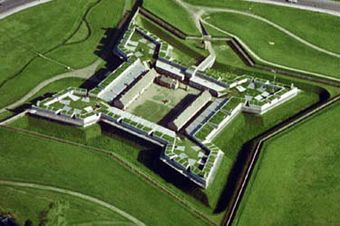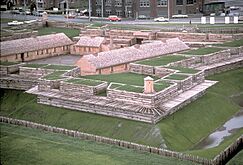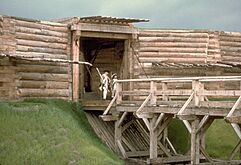Fort Stanwix facts for kids
|
Fort Stanwix
|
|

An aerial view of the rebuilt Fort Stanwix.
|
|
| Location | 100 North James St., Rome, New York |
|---|---|
| Area | 16 acres (6.5 ha) |
| Built | 1758 |
| Visitation | 84,933 (2002) |
| Website | Fort Stanwix National Monument |
| NRHP reference No. | 66000057 |
Quick facts for kids Significant dates |
|
| Added to NRHP | October 15, 1966 |
| Designated NHL | November 23, 1962 |
| Designated NMON | August 21, 1935 |
Fort Stanwix was a fort built by the British starting in 1758 in what is now Rome, New York. It was created to protect an important travel route called the Oneida Carry during the French and Indian War. Today, you can visit Fort Stanwix National Monument, a full-scale replica of the fort built by the National Park Service.
The fort is famous for being successfully defended by American soldiers during a siege in August 1777. During the American Revolutionary War, American forces captured and rebuilt the fort. A British army from Canada then surrounded the fort, hoping to take control of the area. The British failed and had to retreat, which helped the Americans win the much larger Saratoga campaign.
Fort Stanwix was also the location for two important treaties with Native American tribes. The first was the Treaty of Fort Stanwix in 1768 between Great Britain and several tribes. The second was the Treaty of 1784 between the new United States government and the tribes.
Contents
Why Was the Fort Built?
Fort Stanwix was built in 1758 to guard the Oneida Carry. This was a portage, or a piece of land that travelers had to cross while carrying their boats and supplies between two waterways.
This route was very important. It connected the Mohawk River, which flows to the Hudson River and the Atlantic Ocean, with Wood Creek, which leads to Lake Ontario. Controlling this spot meant controlling trade and travel in the region.
The First Treaty of Fort Stanwix
By 1768, the fort was old and no longer in use. However, it became the site of a major meeting between the British and the Iroquois Confederacy, organized by Sir William Johnson.
The goal was to create a new boundary line between Native American lands and the lands where colonists were settling. The British hoped this would stop the fighting on the frontier. The Iroquois hoped a clear border would prevent colonists from moving further into their territory.
The treaty was signed on November 5, 1768. It moved the boundary line much farther west, giving up land in what is now Kentucky. However, the tribes that actually lived on that land, like the Shawnee and Cherokee, were not part of the agreement. Instead of creating peace, the treaty led to more conflict. After the treaty, the fort was abandoned and fell into ruin.
The American Revolution and Fort Schuyler
When the American Revolutionary War began, American soldiers took over the ruined fort in 1776. They rebuilt it and renamed it Fort Schuyler, though many people still called it Fort Stanwix.
The Siege of Fort Stanwix
On August 3, 1777, a British army led by General Barry St. Leger surrounded the fort. This was part of a big plan to cut the American colonies in two. The American commander, Colonel Peter Gansevoort, refused to surrender, and the siege began.
A popular story says that on August 3, 1777, the American soldiers raised the first-ever Flag of the United States in battle. It's more likely the flag was an early design with just 13 stripes, or another flag used at the time.
The Battle of Oriskany
A few miles away, an American rescue force led by General Nicholas Herkimer was ambushed by British loyalists and their Native American allies. This fight became known as the Battle of Oriskany.
While the British were distracted by the battle, soldiers from the fort charged out and raided the enemy's camp. They took supplies and caused a lot of damage. The British were discouraged, and when they heard another American army led by General Benedict Arnold was coming, they gave up the siege and retreated to Canada.
This victory was very important. By stopping the British at Fort Stanwix, the Americans helped cause the defeat of a larger British army at the Battle of Saratoga, a major turning point in the war.
The End of the Fort
The fort was used for a few more years. In 1779, American soldiers launched an attack from the fort against the Onondaga people. On May 13, 1781, the fort accidentally burned to the ground and was not rebuilt.
The Second Treaty of Fort Stanwix
Even though the fort was in ruins, the site was used for another important treaty in 1784. This time, the treaty was between the newly formed United States and Native American nations to settle land issues after the war.
The Fort as a National Monument
In 1935, President Franklin D. Roosevelt declared the site a national monument. At the time, the land was covered by the buildings of downtown Rome, New York.
In the 1960s, city leaders wanted to rebuild the fort to help improve the downtown area. The National Park Service agreed and, after studying the site's archaeology, began rebuilding the fort in 1974. The new fort, made of concrete, timber, and earth, was finished in 1978.
Today, Fort Stanwix National Monument is open to visitors all year. You can explore the rebuilt fort and learn about its history during the French and Indian War and the American Revolution. In 2005, a new visitor center was added with exhibits and artifacts from the fort's past.
See also
 In Spanish: Fuerte Stanwix para niños
In Spanish: Fuerte Stanwix para niños
- List of national monuments of the United States
- Oriskany Battlefield State Historic Site
- Sally Ainse, a woman who once owned a deed for the land where the fort was built





